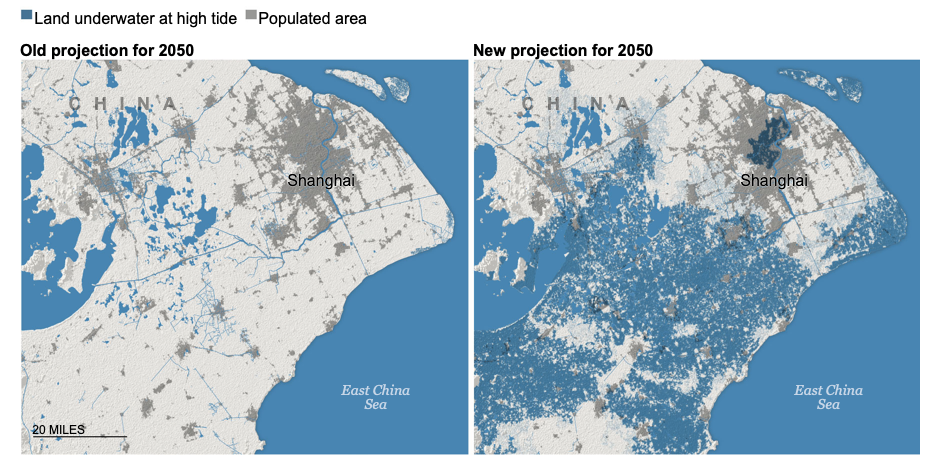300 Million Displaced by 2050?

Last week a new scientific study made the news. The above illustration from the New York Times feature article shows the area of one city – Shanghai – that could flood by 2050. The article had a bold headline:
Rising Seas Will Erase More Cities by 2050
They explained that rising seas could affect three times more people by 2050 than previously thought, threatening to all but erase some of the world’s great coastal cities. That’s just thirty years from now…
The original new research was published in NATURE COMMUNICATIONS, “New elevation data triples estimates of global vulnerability to sea-level rise and coastal flooding” by Scott A. Kulp and Benjamin H. Strauss.
The problem they identified is not that the sea was rising any faster, but that new technologies for determining coastal elevations worldwide were more accurate. The key point was that a much more careful analysis of land elevation increased the assessment of vulnerability. The new research shows that some 150 million people are now living on land that will be below the high-tide line by midcentury – and that’s assuming only a modest sea level rise of 8-12 inches (20-30 cm).
In one of the more extreme scenarios, the numbers double to 300 million people worldwide being flooded out by 2050. That is roughly the population of the United States going underwater in the next three decades. Most of the vulnerability is in eight Asia countries: China, Bangladesh, India, Vietnam, Indonesia, Thailand, the Philippines, and Japan.
Also the article explains that the increasing melting and destabilization of the glaciers and ice sheets in Antarctica now has more scientists thinking we are headed for the more extreme scenarios.
To put this in perspective, in the present day, the world is challenged to deal with a million emigrees and refugees. Imagine that rate increases to ten million a year, with an accelerating pace.
These figures will likely continue to change as the melting rate of Antarctica becomes more clear and as mapping technology becomes better. Over the last two decades, the general trend is that the numbers keep increasing.
The time to begin planning for adaptation is “now.”
I can’t avoid noting that yesterday – November 4th – the U.S. formally announced that it is pulling out of the Paris Climate Accord of 2015, which has the goal to reduce the warming from greenhouse gas emissions. Indirectly this is the cause of the ice melting and sea level rising. Pulling out of that agreement is a step in the wrong direction and will only add to this global catastrophe. The notice legally takes effect after one year, November 4, 2020, which happens to be the day after the next U.S. election.
